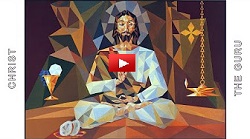Youtube Gallery
Other Videos
Christ The Guru
An intercultural image of Jesus from India
Original drawing by
Fr. Joy Elamkunnapuzha, CMI
for the chapel at Dharamaram College, Bengaluru, India.
Cubist version by M. P. Manoj
Narration By Dr. Joseph J. Palackal , Video Ref. Number : CMSI-212
For copies of note cards, posters, and book marks, please contact This email address is being protected from spambots. You need JavaScript enabled to view it.
Note: Christ is presented here as a yogi in meditation under the sacred peepal tree. He is seated in padmaasanam, the lotus posture. The calm and compassionate look on the face depicts the image of the ideal guru , spiritual teacher, in the Indian scriptures. The hand gestures show jnaanamudra, the sign of imparting knowledge and wisdom that dispel darkness (the Sanskrit term guru is a combination of gu, "darkness," and ru, "that which dispels"). The red color on the hands and feet shows the nail marks from crucifixion. They are the signs that St. Thomas, the Apostle of India insisted on as proof of Jesus's resurrection (Jn 20: 24-29). The equal-armed cross is presented in the form of a flower. The flame represents both Christ and the devotee alike; it is a reminder of two complementary sayings of Jesus: "I am the light of the world" (Jn 8:12) and "You are the light of the world" (Mt 5: 14). The two halves of a coconut, often placed at the forefront during religious rituals in India, is a symbol of self-sacrifice. The chalice with bread and grapes represents the sacrificial gift of Jesus in the holy Eucharist. Joy Elamkunnapuzha drew the original design in 1977, and V. Balan executed it in mosaic style on the facade of the Chapel at Dharmaram College in Bangalore, India. M. P. Manoj made this painting in 1993. Manoj made a few modifications in the original design, including a different color scheme. The entire figure is made of triangles, symbolizing the Christian concept of God as a trinity of three persons. Instead of the earthen lamp in the original, the flame here comes from a hanging oil lamp ( tukku vilakku). This kind of lamp can be seen at traditional homes and places of public worship, especially in Kerala....-
Joseph J. Palackal



